| |
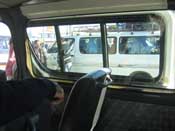
Traveling in a microbus
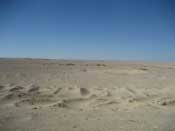
Kilometers and hours of desert

More desert - and a camel
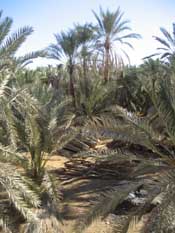
A palm glade
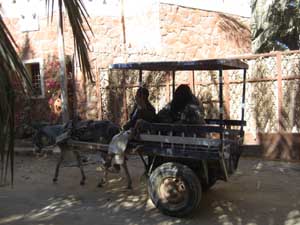
A boy drives the carriage while women sit at the back.
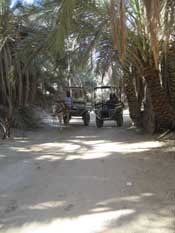
A traffic jam
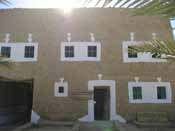
The Siwa House Museum
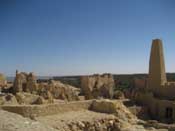
The ruins of the Temple of Amun. On the right is the minaret of the mosque.

The Cleopatra's Bath
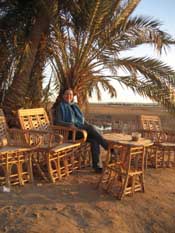
Sunset in Fatnas. Pay attention to all the furniture made of palm trees.
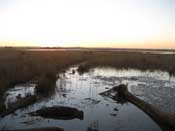
Sunset in Fatnas by a salt lake
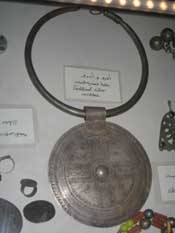
Traditional silver jewelry
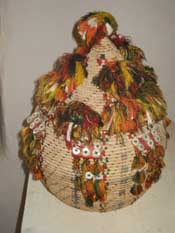
A wedding basket made of palm fronds
|
|
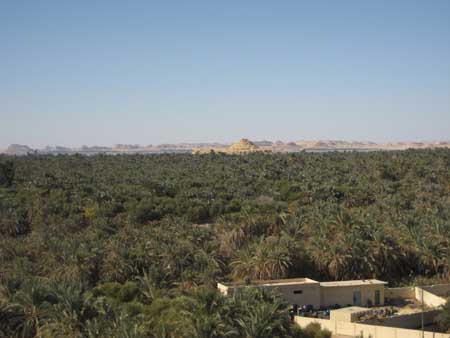
Siwa - Oasis of modern life and long tradition
Published in Ishtar 2/2008
translated by Anu Toivonen
photos by Outi
Siwa is one of the magical oases in the Sahara desert. But do not expect to see the cartoon picture of a single palm tree and a pond!
On an endless sea of sand, the spring water generates large glades of palm trees: you can actually see very little water but you can sense it in every tree. From above, the Oasis looks like a vast palm forest dotted here and there with sand-coloured settlement areas.
Townscape
The town centre is very small: three streets and a market place are practically all there is to see. But, after all, during a few-day visit a couple of restaurants, several souvenir shops and a bookshop are all a tourist really needs.
The bookshop displays the Siwa-book of a young local anthropologist - I recommend the book, although the male point of view is at times painfully obvious. The single Internet Café proves that the Internet has also reached far into the desert.
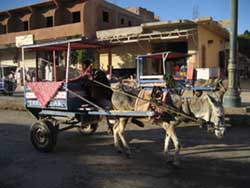
The Siwa taxi
|
You don't see many cars; donkeys and bicycles rule the streets. As the area is rather small, the bike is quite a splendid way of locomotion and most distances can easily be covered within a quarter of an hour. The Siwa taxi is an adorable sight as the donkey munches its lunch of hay in between trips. The beasts are harnessed in front of a small carriage comfortably accommodating two or three medium sized people - the taxi may be a little crowded if the passengers are of a larger size!
You can see only a few women on the streets and they usually move about in small groups, almost never alone. Tradition forbids these women to ride a bike or drive a carriage. It is strange to see three adult women sitting at the back of a carriage driven by a five-year-old boy.
|
The people
The people are marked by a long history of several conquerors coming from outside the Oasis. These have turned the Siwans into aggressive defenders and quite self-sufficient. They highly value their independence and are proud of their special inheritance and customs.
The Siwan identity is rather North African than Egyptian. Most Siwans are of Berber origin, their ancestors once having come from the North African coast.
The Berber were living here already 10 000 BC, moving closer to the coast as the land eroded and fleeing inland when pursued by a hostile enemy. The last Arab attack in the 9th century turned these stationary Berber into nomadic Bedouin, which explains their traditions' affinity to those in Morocco and Tunisia rather than to those of the surrounding western Egyptian desert.
Siwi, the language of the Oasis, has its roots in the Berber history of the people - a similar language is spoken also in Libya. Siwi is a spoken language only, although Voula Alexander, a Greek anthropologist, believes the geometric embroidery in Siwan clothes to be a long forgotten alphabet.
Siwa is also an important - and the last - stop on the caravan route before the Libyan Desert. The Berber inheritance is manifested in the red hair and blue eyes in some of the inhabitants, whereas the former slave market has brought with it the dark skin and other African features.
The present day Siwans form two distinct families, the eastern and the western, each divided into smaller communities. The family elders have been and continue to be very important in solving disputes, preserving tradition, administering justice and acting as scribes recording Siwan events. No intermarriage occurs between the eastern and western families, and the dark African and Berber blood are not allowed to mix in marriage either.
Tourist attractions
The Oasis centre is governed by the citadel of Shali rising high above the houses. Shali, also the Siwan name for their town, was founded in 1203. The citadel was built on the highest spot and the walls were strengthened with massive salt blocks.
The Shali has two underground springs and at least one underground tunnel leading outside the walls. The Siwans in the Shali were self-sufficient for centuries and defended their citadel against intruders.
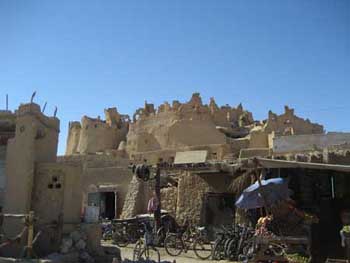
The Shali is visible on the background.
|
The worst enemy of the Shali is the climate: the average of three rainy days in 25 years does not sound much, but the salt in the walls dissolves in the rain water. In 1928, after a three-day rain, the citadel was abandoned and rains in 1930 and 1970 as well as the latest two-day storm in 1982 have all contributed to the wall meltdown.
The Shali walls look like melting yellow ice cream: all sharp angles have been rounded and the walls have grown very low. At present, the Shali is very dangerous in places and the danger of collapse reduces the number of walkways. Yet some houses are still inhabited and lines of drying laundry give an idea of what the town looked like in the past. In the evenings, the Shali is bathed in lights reflecting off the walls and making the citadel look majestic.
|
The Siwa House Museum near the bus station displays artefacts depicting various aspects of the Siwan life. Short but informative texts explain the use of the objects and they are the best the museum has to offer. The museum is situated in a house built in the traditional way where every room has a special function in the everyday life. The museum boasts traditional women's silver jewellery, musical instruments, wedding costumes, baskets and ceramics.
The Oracle
After the noisy Cairo, the peace and quiet in Siwa feel incredibly luxurious and from the first, the visitor is calmed by the clean air and simple life of the Oasis. In addition to this, the Siwan attractions include the temple of Amun and the Oracle.
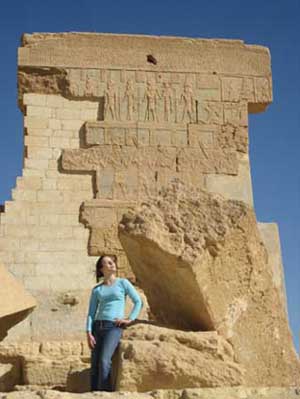
The Oracle: the old hieroglyphs are still visible on the stone.
|
The temple of Amun stands on the Aghurm Hill and it was constructed in 663 - 525 BC. Dedicated to Amun, the god of life, the present day temple consists of the outside walls and within them, a well and the remains of the walls of two rooms. All that is left of the old wall scriptures are a few words translated by Simpson: ' Life itself, feet like silver, skin like gold, hair like sapphire and horns like emerald'. Major part of the temple has been destroyed and its treasure has been lost or stolen in the past. However, the view of the Oasis from the temple is still magnificent. You can clearly see the greenery of the palm glades as well as the brown colours of the settlements. The surface of the salt lake glitters and sparkles in various colours. A more recent addition on the hill is the mosque built on top of the temple entrance. The mosque has been renovated a few years ago being currently quite simple in its interior decoration.
The sacred remains of the Oracle have deteriorated to almost nothing in the past millennia. In ancient times, the Oracle was highly revered and people came over long distances to consult it. Even Alexander the Great is believed to have come to the oracle to find out about his origins; he wanted to make certain he was the son of Zeus, the chief god in Greek mythology. The Oracle's confirmation of the matter also meant that Alexander had the divinity of the Egyptian pharaohs running in his veins.
|
The Romans did not value the Oracle, and already in the first decades AD the Oracle's position was lost. Today, all that is left of the temple of the Oracle are a few stones with, in addition to the hieroglyphs, the inscriptions of names such as Mohammed, Adel and other more modern personages.
In the shade of a palm tree
The main industry in Siwa is farming and the principal products are olives and dates. The Siwan dates are said to be the best in North Africa.
Most Siwans consume dates and olives at every meal. These are preserved and prepared in various ways. Even the donkeys feast on the sweet dates and some clearly protest if deprived of their daily treat. In the last few years, the olives have become the most important farm produce. They are either eaten or preserved in salt liquid or oil is pressed from them.
Earlier, the Siwans grew more grain and other edible plants and life was quite self-sufficient. Dates and olives were taken to be sold outside by the caravans, which on their return trip brought the missing items such as tea, coffee, sugar, cloth, scissors, soap and tobacco leaf. Farming dates and olives is more productive so, today, the grain and other staples such as fruit, vegetables, lentils and beans are brought by large trucks.
The Siwans know how to utilise every part of the palm tree; the materials for palm glade fences, roofs, furniture, carpets and the countless different types of baskets all come from palm trees. The first bonfire I've seen in Egypt was on a Siwan market place in the evening - wood is too precious to be burned in a large open fire elsewhere in Egypt.
Springs of Life
Without the fresh water springs there would be no life in Siwa. The lakes surrounding the Oasis are too saline for any kind of life making fishing impossible; there is not even a single boat in Siwa.
Even the relatively fresh spring water is sufficiently saline for only a few plants - the date and the olive - to tolerate it in irrigation. The Siwans do not buy salt, they get it once a year straight from the Salt Lake. At home, the women then grind the salt according to need.
The most famous spring in Siwa is the Cleopatra's Bath in which the travellers have been bathing for millennia - Cleopatra herself is said to have bathed in this spring on her visit. In ancient times, it was believed that the water temperature changed according to the time of day, but this belief has been proven incorrect in modern times.
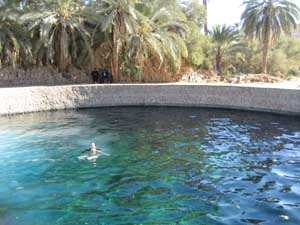
Outi swimming in the Cleopatra's Bath.
|
Today, the Cleopatra's Bath is an important tourist attraction. It is situated in the middle of a road - the road branches to go around the Bath. Beside the Bath, there is a coffee house, a small kiosk sells souvenirs and behind the coffee house, there is also a small bath-house where you can change into your bathing suit. Men can swim and jump into the water in shorts, but women should give some thought to their attire as the local men are used to seeing only one eye of a woman. Even on a mild December day after a short bicycle ride the water was refreshing; on a hot summer day it must be heavenly! It was wonderful to swim after a long while - perhaps some of Cleopatra's charms were absorbed into my skin as well.
|
Fatnas, another spring, is situated on an island in the middle of the Salt Lake. The island's palm trees form idyllic surroundings for a swim. As the evening grows cooler, the water feels nicely warm to the touch. Fatnas is protected enough to ensure there is no need to fear a crowd of local onlookers. If you are not interested in swimming you can sit about 50 meters away, across the island, in the palm chairs of a small café and sip karkadeh. If you time this right - like we did - you can admire a beautiful and colourful sunset.
To Siwa and back
Siwa boasts a brand new airfield, so the easiest way to get there is to take a plane. Other modes of transport are bus and microbus. When travelling from Cairo, you need to go via Alexandria or Marsa Matrouh. The fare to Marsa Matrouh by bus cost £E 46 (less than 6 €) and lasted for six hours. The return trip in a microbus took only five hours and cost £E 23 (less than 3 €).
The trip between Marsa Matrouh and Siwa took merely three hours in a microbus and cost £E 17 (a little over 2 €). Even though a microbus is both cheaper and faster than a bus you usually can, on a bus, enjoy more comfortable seats, at least some kind of air conditioning and nice Egyptian films. On a long trip, these can make all the difference.
Even though a one-way trip from Cairo to Siwa took ten hours, it was worth it. With the new airfield and a larger hotel under construction more and more tourists will find their way to Siwa. Tourism will bring more income to the Siwan people raising their standard of living, but this is also likely to change their everyday life. Hopefully, they are able to maintain their own customs and traditions or at least their own special cultural features.
Tourist attractions
During a short two-day visit I had no time to fully explore Siwa and its possibilities. However, here are some tips:
The mountains surrounding the Shali hide a vast amount of history. Gebel al Mawta, the Mountain of the Dead, is situated to the north of the city. The people fled to that mountain during the WWII air raids and found ancient tombs. The original wall paintings depicting ancient Egyptian gods such as Hathor and Osiris can still be seen in some of the tombs.
You can find several old buildings scattered around in Siwa. The temple ruins, remains of the old Roman town and deserted houses tell us of the long and colourful history of the area.
Safaris making excursions to the desert are very popular among the visitors. You can choose among several alternatives from day-trips up to trips lasting a few days during which the tourists will sleep in the cold desert night.
The Siwan Marriage
Earlier, the bridegroom's mother used to look for a suitable wife-candidate for her son. If her husband liked her candidate, negotiations could be opened with the girl's parents who decided their daughter's fate. The parents did not inform their children of the engagement, and usually the girl heard about it from her friends. She had no way of refusing or breaking off the engagement.
Today, the groom chooses a pleasing bride and the girl is allowed to break off the engagement once old enough. The groom's mother will focus on the girl's industriousness and skill as well as her family's reputation whereas the boy will be interested in his bride's beauty.
As a girl may be promised in marriage as young as five years of age, the engagements tend to be very long. In this way the groom can reserve himself a good bride before the other men get their chance. Earlier, there were more boys than girls, so the reservation system was rather sensible. Today, as the girls by far outnumber the boys, the girl's parents are happy to receive early marriage proposals. The age of entering an engagement and marriage has recently been rising.
Though the ways in Siwa are still a far cry from the freedom in Cairo, the traditions are changing. Today, the engaged couple can meet two or three times a year, when the man brings gifts - a ring, chocolate, a watch or some other small present - to his chosen bride on certain holidays. Talking is, of course, not allowed and when meeting him on the street, the girl must treat her fiancé like air or - preferably - run away!
During the last couple of years, having an engagement party has become popular. Because of the cost, the parents do not favour a large party, but especially the brides want to have the kind of celebration their friends have had. The engagement is a women's feast where all women in both families - with the exception of the groom's mother - will assemble to have a good time. The groom sits in another room with the other men.
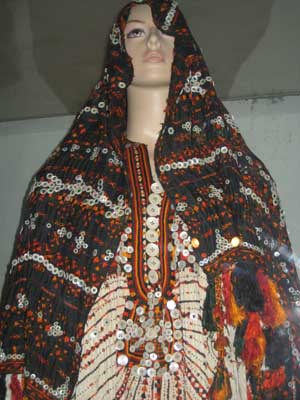
Traditional wedding dress with beautiful embroidery.
|
Earlier, the wedding celebration used to last for seven days, but today it only lasts for three. The celebration starts on the signing of the marriage contract. Before, both the bride and the groom bathed in the Tamus Spring - the bride in the morning and the groom in the evening. Today, the bath takes place at home or in a neighbour's bathroom. In the evening, after being decorated with henna and also in other ways, the bride is taken to the groom's house.
On the following days, the men will visit to congratulate the groom and his father as well as the father of the bride, whereas the women will call on the bride and her mother. The groom only visits his bride at night, as many of the women staying in the house during the day are not related to him and he is not allowed to see their face or spend time in their company.
Earlier, the bride dressed in three different costumes specially made for the wedding: her mother had started on the embroidery already when the girl was only a few years old. Today, she only wears one dress. The bride wears a western-style white dress, as in Cairo, and only on the first day of her marriage will she wear the traditional costume. The simple costume of the groom remains unchanged.
|
Tarfottet
After their marriage, the women don the traditional shawl whenever they venture out of doors. The blue-and-white, rectangular tarfottet covers its wearer from head to toe. One hand holds the shawl in front of the face leaving only a narrow slit from which to see with one eye, the other holds the shawl tightly closed across the breast.
Recently, the nigab has arrived in Siwa from other parts of Egypt. The women cover their face with a black chiffon veil leaving one arm completely free and the tarfottet to hang more loosely beside the face. The nigab completely covers the eyes.
The middle of the shawl, waist-high, boasts red, orange, and dark-green embroidery done with silk thread. The horisontal decoration tells a story of its bearer. The first shawl is made for the bride by the women in the groom's family. The embroidered band is broad, approximately 10-15 cm wide and the embroidery is lavish. As time passes, the band grows narrower and the time spent doing the embroidery diminishes. Old women carry a band of only a couple of centimetres with no special pattern. If the shawl bears no band at all, the wearer is very old indeed.
The material for the tarfottet comes from a village in Giza, outside Cairo, where it is especially made for the Siwan women. Lately, the price has gone up which has made the Siwan ladies to start wearing abayas like women elsewhere in Egypt do.
Siwan history in a nutshell
During its history, Siwa has been called by many names: Santariya, The Oasis of Jupiter-Amun, Marmaricus Hammon and Palm Garden.
Siwa was believed to have been the capital city of a wide realm. During the Old Kigdom, it belonged to Tehenu, the Land of Olives, which reached all the way to Maretis. There is very little information on Siwa from the times of the ancient Egypt. In later times, several conquerors marched into Siwa: Alexaner the Great and Musa Ibn Nusayr - the bringer of Islam - as well as Muhammed Ali have in their turn annexed this important Oasis, sometimes in a bloodbath.
During both World Wars, Siwa was an important military theatre. In WWI, it suffered from Libyan Sanussi and English crossfire and in the WWII, both the Allied forces and the Germans had a military base there.
For nearly twenty years, the Siwan connection to the outside world was being limited and tourism and visitors were not allowed. These limitations were lifted in the 1980's and after this, the town has greatly changed.
|
|